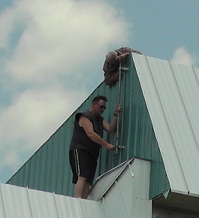|
Gordonsville Municipal Airport Repeater Station
|
| Elmer (K4UCI) |

|
| Sponsor of 444.400 Mhz Repeater Station |
|
Thanks to Elmer (KF4UCI) of Charlottesville, Virginia
GAPS is proud to announce the installation of a public use amateur radio repeater station at Bluebird Aerodrome next
to the Gordonsville Municipal Airport at Gordonsville, Virginia.
The 70cm (444.400mhz) repeater can be accessed at 444.400 mhz with a tone of 151.4hz. This repeater is open for
public use and will also serve as a training station for any HAMs in the area that want to practice and learn
HAM radio operations. It also is available for emergency communications.
Thanks Elmer Scott, Fred Dean, and Mike Colburn for all your hard work and money put into setting up our repeater
station!
|
What does the acronym HAM represent?
Hi Faith,
As
you might have discovered, there are many theories as to the origin of the phrase ‘ham radio.’
What we do
know for sure is that during the late 19th and early 20th century the term 'ham' referred to an amateur. So it is fitting
that amateur radio operators were called ham radio operators:
Oxford English Dictionary entry:
ham2 /ham/
▶noun
2. (also radio ham) (informal) an amateur radio operator.
late 19th cent. (originally US): perhaps from the first syllable
of amateur; compare with the US slang term hamfatter ‘inexpert performer’. Sense 2 of the noun dates from the
early 20th cent.
Unfortunately, there is not an answer to your question what does the letters HAM stand for. The following
author <http://www.w7eca.org/whyham.htm> states it best "The true reason why amateur radio operators came to be called
"HAMS" is no longer known. More specifically, the truth has been lost to time over the many years."
You also might wish
to explore the references in the following website on radio history-
<http://earlyradiohistory.us/sec022.htm>
One of the earliest mentions to an ham radio operators is found in the
following
"Telegraph Talk and Talkers", from the January, 1902 issue of McClure's Magazine, author L. C. Hall noted "It
is an every-day thing to hear senders characterized as Miss Nancys, rattle-brains, swell-heads, or cranks, or 'jays,' simply
because the sound of their dots and dashes suggests the epithets." Hall's review further noted that "senders of hog-Morse,
called technically 'hams' " were known for their propensity for transmitting garbled Morse code. " As you can see, this mention
of 'ham' predates the other theories."
I consulted with my grandfather who was a ham operator from 1940-1990's. He told
me it simply means an amateur radio operator and that he has never heard of HAM used as an acronym.
In my opinion, as
the popularity of ham radio evolved, so did the theories of what 'ham' could represent.
Ms.
Jennifer J. Harbster, MLIS
Research Specialist
Recommending Officer- Agriculture, Mathematics, and Meteorology
Science,
Technology, and Business Division
Library of Congress
|
Two GAPS members Fred (top) and Mike (N4HRO - side) work together with the repeater's sponsor Elmer to install the
new repeater on the roof of Bluebird Aerodrome. Bluebird Aerodrome is located next to the Gordonsville Municipal Airport and
the site of the GAPS (Gordonsville Airport Preservation Society) meetings.
| Mike, N4HR0 and Fred |

|
| Bluebird Aerodrome located next to KGVE |
|
|